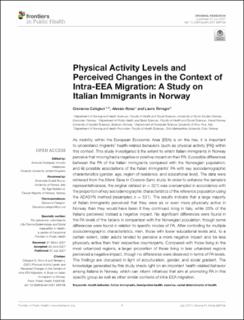Physical activity levels and perceived changes in the context of Intra-EEA migration: A study on Italian immigrants in Norway
Peer reviewed, Journal article
Published version
Permanent lenke
https://hdl.handle.net/11250/2978438Utgivelsesdato
2021Metadata
Vis full innførselSamlinger
Sammendrag
As mobility within the European Economic Area (EEA) is on the rise, it is important to understand migrants' health-related behaviors (such as physical activity [PA]) within this context. This study investigated i) the extent to which Italian immigrants in Norway perceive that moving had a negative or positive impact on their PA; ii) possible differences between the PA of the Italian immigrants compared with the Norwegian population; and iii) possible associations of the Italian immigrants' PA with key sociodemographic characteristics (gender, age, region of residence, and educational level). The data were retrieved from the Mens Sana in Corpore Sano study. In order to enhance the sample's representativeness, the original dataset (n = 321) was oversampled in accordance with the proportion of key sociodemographic characteristics of the reference population using the ADASYN method (resampled n = 531). The results indicate that a large majority of Italian immigrants perceived that they were as or even more physically active in Norway than they would have been if they continued living in Italy, while 20% of the Italians perceived instead a negative impact. No significant differences were found in the PA levels of the Italians in comparison with the Norwegian population, though some differences were found in relation to specific modes of PA. After controlling for multiple sociodemographic characteristics, men, those with lower educational levels and, to a certain extent, older adults tended to perceive a more negative impact and be less physically active than their respective counterparts. Compared with those living in the most urbanized regions, a larger proportion of those living in less urbanized regions perceived a negative impact, though no differences were observed in terms of PA levels. The findings are discussed in light of acculturation, gender, and social gradient. The knowledge generated by this study sheds light on an important health-related behavior among Italians in Norway, which can inform initiatives that aim at promoting PA in this specific group as well as other similar contexts of intra-EEA migration.

